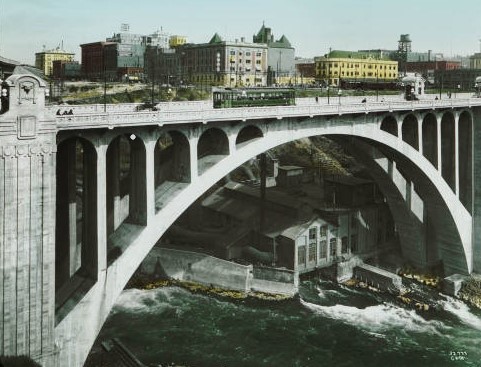Engineer John Chester Ralston was born in 1864 in Kincardine, Canada. His extensive achievements in the field of engineering are particularly noteworthy, since he had initially had no formal education in the subject. His knowledge was self-taught and reinforced through on-the-job experience. Ralston was fortunate to work in the early stages of his career under mentors who took a strong interest in his development and guided him along.
In 1877, upon the death of his father and at the age of 13, John was forced to discontinue schooling in order to take odd jobs to help support his family. In 1880, he left Canada to go into the American West. There he found employment in the U.S. Army Corps of Engineers, in the reclamation of the Missouri River. It was under the encouragement and personal help of the engineering staff that John's engineering self-education was directed and inspired. The nature of the pioneering improvement plans of the Missouri River was ever fascinating and inspiring, and the complexities of the laws of hydraulics, the dynamic conditions of the water flow and channel erosions, the numberless problems and the constant search for control remedies, were a challenge in engineering study. Under such a special environment the college classroom as an educating medium was surpassed. Only in later life did John undertake a more formal course of study, attending classes at Columbia University and the University of Chicago.
In 1882 he was transferred from the Missouri River at Omaha, Nebraska, to the Potomac River, and began working on the reclamation of the Potomac Flats at Washington, DC, and Georgetown, Maryland, harbors, and on the building of what afterward became Potomac Park, Washington, DC. He was given responsibility for the construction of the mattress foundation of the seawall behind which the channel dredging’s were deposited to form the land of this interesting park. This seawall was more than five miles long and required several seasons to complete. The wall defined the final north shoreline of the main channel of the Potomac River from Georgetown Harbor, enclosing a peninsular area that separates the two main navigable channels. This area reclaimed a large and offensive part of the mud flats of the Potomac River, while the dredging’s from the widened outside channels supplied the necessary material to raise the flats well above high tide and to create a fertile acreage for landscape gardeners. More than 400 acres were reclaimed as part of the project.
In 1885, when after the major part of the reclamation had been completed, Ralston was offered a position as Assistant Engineer on the Construction Staff of the Union Pacific Railroad. For the first two years of his railroad experience, he was employed directly by the noted engineer Jacob Blickensderfer who taught him in the art and science of astronomical observation.
In 1887, a new Chief Engineer was appointed, and he granted Ralston his long-cherished wish to be put into the field. An extended experience in preliminary and final exploration sites in many of the rugged western states, including Colorado, Wyoming, Nevada, Western Montana, Eastern Washington, and Idaho, and on construction work in Kansas, Nebraska, Colorado, Wyoming, and Montana, gave him an extensive understanding of railroad engineering. In his new role he was given charge of the remodeling of the Butte, Montana, railroad yards to meet the growth of the expanding mining industries of that region. Other notable work was the selection of preliminary and final paths of the high-line RR route of what, in later years, became the famous Butte, Anaconda, & Pacific Railway, the first electrically operated, heavy-freight carrying railroad in the world. Ralston also helped with the development of Butte, Montana’s waterpower system.
In 1889 and 1890, he took charge of the preliminary surveys and much of the final routing of the west end of the Pacific Short Line through Wyoming and Utah, employing and directing a half dozen field parties. He succeeded in shortening the main-line distance 90 miles between the Missouri River and Ogden, Utah, and in finding the most economical crossing of the Continental Divide, nearly 1200 ft. lower than that of the nearest competitor.
By 1890, the first period of his career ended, when a suspension of active railroad development in the West was declared. Ralston immediately took up a private practice and started to specialize in steel skeleton building construction, and foundation work. During this period, he worked on a number of early steel skeleton buildings in the city and elevated railway tracks for the Illinois Steel Company. He also designed projects in Buffalo, NY; and Pittsburg, and Philadelphia PA.
In 1897 Ralston married Mary Kean Buckner of Kentucky, and at the urging of friends in Butte the couple decided to go west making their way to Spokane. From 1897 to 1906, Ralston worked at offices in Spokane and Republic, as chief engineer for the Republic Mines. On the side he established himself as a Consulting Engineer, and his practice quickly grow and covering examinations, reports, and valuations in the fields of hydraulic development, hydraulic power, and later, hydroelectric power in British Columbia, Washington, Oregon, Idaho, California, Montana, and Nevada.
While visiting San Francisco in April 1906, he was severely injured by the great earthquake that destroyed much of that beautiful city. Ralston underwent major surgery and was left a permanently disabled. This put an end to all field activities and left him physically able to pursue only a limited consulting practice.
Despite his physical handicap, in 1907 he decided to accept an appointment as City Engineer for the City of Spokane. His first task was to reorganize the engineering staff. He succeeded in bringing into the sadly depleted organization an esprit de corps and a technological staff of singular merit, one comparable to the best metropolitan standards.
 In spite local politics, a two-year period of decisive and productive engineering activities followed. Under this regime, he was able to replace eight old and dilapidated wooden Howe truss bridges by designing and building an equal number of reinforced concrete structures, literally making Spokane the "City of Bridges". Among these structures was his crowning achievement, the Monroe Street Bridge (1909), said by many at the time to be the most monumental concrete arch bridge in the United States. The main deck is a segmental arch of 290 ft. span, with a rise of 140 ft., making it the longest concrete bridge in the nation in that period. Other notable projects included the Washington Street Bridge (1908, demolished in 1974); the North Channel Howard Street Bridge (1909); the Olive Street Bridge (now called Trent Avenue, east of Hamilton, 1909); numerous paving projects; and a new underground water supply system.
In spite local politics, a two-year period of decisive and productive engineering activities followed. Under this regime, he was able to replace eight old and dilapidated wooden Howe truss bridges by designing and building an equal number of reinforced concrete structures, literally making Spokane the "City of Bridges". Among these structures was his crowning achievement, the Monroe Street Bridge (1909), said by many at the time to be the most monumental concrete arch bridge in the United States. The main deck is a segmental arch of 290 ft. span, with a rise of 140 ft., making it the longest concrete bridge in the nation in that period. Other notable projects included the Washington Street Bridge (1908, demolished in 1974); the North Channel Howard Street Bridge (1909); the Olive Street Bridge (now called Trent Avenue, east of Hamilton, 1909); numerous paving projects; and a new underground water supply system.
His career at the city ended in 1910 when politics took over and Ralston was unjustly removed from his position by the City Council, citing alleged incompetence. His assistant was promoted into his chair.
Afterward Ralston continued to act as a consulting engineer, reporting on a number of hydroelectric projects. Prior to the entrance of the United States into and during World War I, he served as a member of the Naval Consulting Board for the State of Washington. During this time, he was also one of about 2,000 entrants who were asked to submit plans and specifications for the dissemination of American propaganda among the German people. His plans were accepted, and he was one of the first four to receive Presidential recognition and a monetary reward.
Ralston also served as a member of the Committee on Development of the American Society of Civil Engineers, sharing actively in its deliberations during the period 1918-1920. From 1920 to 1924, he served as a member of Engineering Council. In the Council, he served as the Executive Member, for the states of California, Nevada, Oregon, Idaho, Washington, and Montana.
From 1900 until 1918, he acted as Consulting Engineer, and, for a part of that time, as Vice-President, of the Pacific Coast Pipe Company with a factory at Seattle. This company manufactured all sizes of wood-stave pipe. He was one of several engineers on the Pacific Coast who developed and made popular this type of pipe for more extended use, and this work is considered to have been a great contribution to the current engineering practice of the time.
Ralston was an early proponent of the Boy Scout movement, a pioneer in the social hygiene movement, a deep lover of the arts, and ever willing to aid in the betterment and beautifying of his city, having planned outlines for the economic and scenic development of the falls and rivers of Spokane. He served as President of the Art Association, and was a brilliant, original, and much sought-after speaker. He was a member of the Spokane Engineering Society, the Seattle Engineering Society, the American Institute of Mining and Metallurgical Engineers, the Cosmos Club of Washington, DC, the Spokane City Club, and the American Society of Civil Engineers. Ralston was also a 32nd degree Mason, a staunch Republican, and a communicant of All Saints' Episcopal Cathedral.
He continued to work as a consulting civil and mining engineer until his death at the age of 64 on July 15, 1928. He was buried next to his wife in Cave Hill Cemetery in Louisville, Kentucky.





